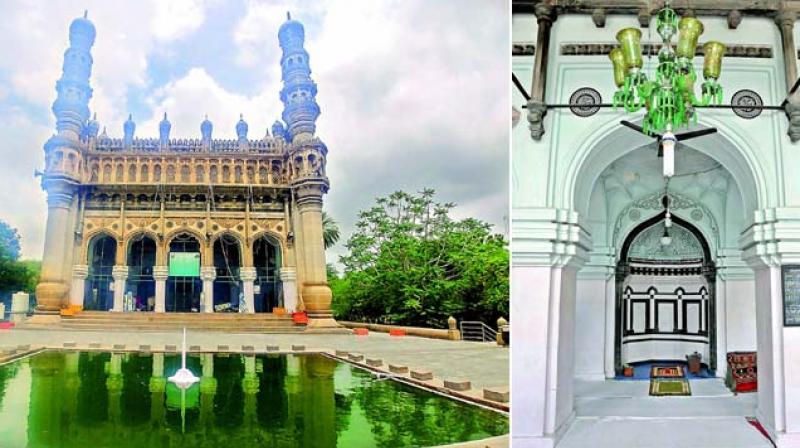Hyderabad: At 350-year-old Toli Masjid, time for quiet reflection
Encroachers with political clout have usurped its land.

Hyderabad: It is a gorgeous looking mosque with detailed and intricate designs carved on the exterior. Toli Masjid in Karwan, Hyderabad, was constructed in 1671-72 AD by Mir Musa Khan Mahaldar during the reign of Abdullah Qutb Shah. It received the INTACH award in 2005 and according to the citation, is the crowning glory of Qutb Shahi architecture.
It is located near the Kulsumpura mosque and Karwan-e-Sahu, the old Qutb Shahi suburb of Karwan on the historic Golconda-Hyderabad route.
The citation adds that the mosque is a symphony of stucco, profusely decorated with exquisite designs and patterns. It is a tribute to the excellence and superiority of workmanship attained by Qutb Shahi craftsmen.
While the mosque still stands in all its glory, the 27 acres and five guntas which belonged to it have been encroached upon. In fact, the mosque stands in the middle of a shanty town though a board declares that this is a protected heritage site of the Archaeological Survey of India.
“Even a couple of years ago there were gardens," says INTACH convenor Anuradha Reddy. Now it is open ground where children play. A well in the corner which must have been deep and full of water is now covered up.
Mir Musa Khan employed the architect of the Macca Masjid of Hyderabad and royal architect of Sultan Abdullah Qutub Shah to design it. Toli Masjid is also known as Damri Masjid.
The mosque is built on a raised platform with a high plinth. It is divided into two halls, the outer one having five arches with the central arch being slightly wider and more ornate. The five arches may probably represent the Panjatan or the People of the Cloak — Prophet Muhammad, his daughter Fatimah, his cousin and son-in-law Ali and his two grandsons Hassan and Hussain.
The citation says, “A second row of three arches inside forms two aisles to accommodate worshippers. A remarkable feature is the deliberate use of granite and basalt in embellishment. The decorative granite columns start at each arch and soar up to the roof.”
Though most of the mosque is in stucco, the medallions on either side are of black basalt with Quranic inscriptions. The contrast is visible. A single row of polished black basalt pot-shaped discs run across the façade over the arches.
Two minarets, each 20 metres tall, flank the edifice supported by massive octagonal columns with pot-shaped bases. The parapet is a series of miniature arches with jalis of different patterns, lending it an elegant look. The upper half of this mosque is the most beautifully decorated. Above the jalis are elaborately decorated minarets with carved mouldings and petals.
The interior of the prayer hall is divided into two naves, one smaller than the other. There are two miniature representations of a three-arched mosque in stucco on the side walls of the inner aisle, and two unembellished jharokhas. The inscription inside the Mehrab mentions the names of Musa Khan and Abdullah Qutb Shah along with Ayala Kursi or the famous verses of the Quran. There is an arched pavilion supported by the octagonal columns, brackets and lintels with a dome exactly above the Mehrab.
Earlier there used to be a Qutb Shahi style fountain but while the beautiful floral outer design remains, it is in total disuse. There is a wazoo khana and a fountain. And if you stand at a particular angle the entire mosque is reflected in the green and now dirty water of the fountain. “In summer the water does get murky, but the reflection happens because the mosque is 60 feet in width and 100 feet in height and if you stand in the correct position you can see the mosque beautifully reflected, in proportion, in the water of the fountain,” says Mohammed Mehmood, vice president of the mosque.
As mentioned earlier, the mosque stands amidst houses, with no land of its own and as Anuradha Reddy points out, “with no care taken, trees are growing out of the minarets{”.
No one looks after the mosque, though it has a president, Syed Dastagir Pasha, and vice president, Mohammed Mehmood. “The building is state-protected, but no one comes. No one from the state archaeology department and no one from the Wakf Board," says Mr Mehmood.
Those who have usurped the surrounding land have political influence and the place is full of illegal constructions. Several cases are pending against the people who have built on the land. Ironically, though this is a protected building, a six-lane highway is being built exactly behind the mosque, which could endanger its stability.
Deputy Chief Minister Mahmood Ali has been informed of the encroachment and in fact, 49 representations have been sent by the Wakf Board, but all have been ignored by the state government. It is said that the encroachers of the Toli Masjid land are so powerful that no action can be taken against them.
Those looking after the Masjid want a CB-CID inquiry on how the 27 acres and five guntas of masjid land were encroached upon. The market value of the land would be roughly '600 crore today.

